Content
- Composition and form of release
- Characteristics of the drug
- Indications for use
- Contraindications for use
- During pregnancy
- Does it help with headaches
- Adult use
- Application in children
- Side effects
- Overdose
- Drug interactions
- Video about the drug No-shpa
No-Shpa - antispasmodic drug based on drotaverine, designed to relieve pain in spasm of smooth muscles. The drug prescribed for the relief of headaches, stomach and intestinal cramps, hepatic and renal colic has high efficiency and practically does not cause side effects, which makes it permissible to use it in children and older persons age.
Composition and form of release
No-Shpa from the head is used as an antispasmodic drug that helps to quickly relieve stress-induced pain syndrome and alleviate the patient's condition.
Produced by Hinoin. Factory of Pharmaceutical and Chemical Products "(Hungary) the drug is a round, double-shaped yellow tablet (greenish or orange) shade with a fault line in the middle and the inscription "NOSPA" on a monolithic surface with a reverse sides.
A medicinal product is produced:
- in tablet form, packaged in 6, 10 or 24 tablets in each foil blister or placed in polypropylene bottles with a special dispenser (60, 64 or 100 pcs. in each);
- in the form of an injection solution used for intramuscular (i / m) administration (25 ampoules of 2 ml in each package).
The drug is made from:
- drotaverine hydrochloride (40 mg);
- magnesium stearate (3 mg);
- talc (4 mg);
- povidone (6 mg);
- corn starch (35 mg);
- lactose monohydrate (52 mg).
The shelf life of the medicinal product is:
- 5 years for No-Shpa in tablet form;
- 3 years for injectable solution.
It is recommended to store the drug in a dark place, out of reach of UV rays and small children, at an air temperature not exceeding 25 ° C.

The drug is distributed through retail or online pharmacy chains at a cost:
- from 140 rubles. for the tablet form of the drug;
- from 450 rubles for the injection solution.
Characteristics of the drug
No-Shpa is a tablet or injectable antispasmodic drug used to quickly relieve spasms of smooth muscles, headache and dysmenorrhea. Based on the phosphodiesterase IV type (PDE IV) inhibiting actions of drotaverine, the drug has a powerful antispasmodic effect, gradually relaxing smooth muscle cells.
Pain relieving drug:
- effective for neurogenic dysfunctions and muscle spasms;
- helps to relax smooth muscle cells located in the gastrointestinal tract, biliary tract, genitourinary system;
- due to the vasodilating action, it improves tissue circulation;
- due to the provision of a sedative and suppressive effect on the isoenzymes PDE III and PDE V, it is used in the treatment of various forms of dyskinesia.
When it enters the body, drotaverine enters into a connective reaction with plasma protein, is distributed through tissues and penetrates into smooth muscle cells. The drug does not change the state and structure of the blood, and in a small amount passes through the placental barrier.
The maximum concentration of the drug in plasma is detected 35-60 minutes after the intake. The drug is metabolized in the liver.
Indications for use
No-Shpa from the head is used as an effective drug for relieving tension pain syndrome, accompanied by spasm with pressing or bursting sensations.
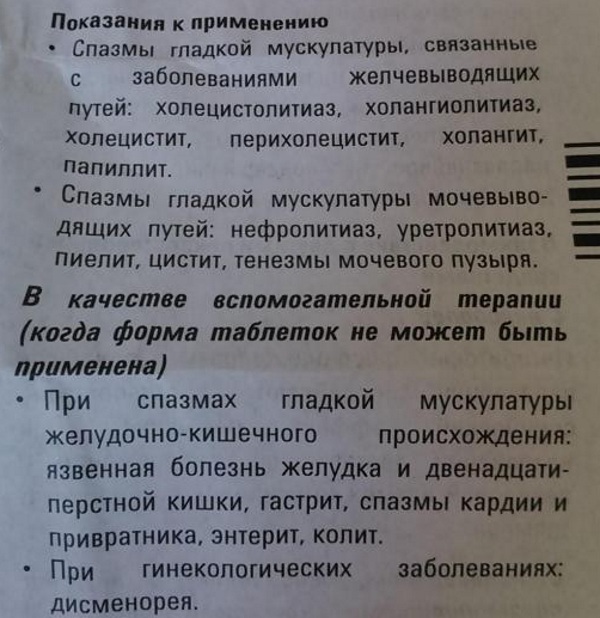
Reasons for using the medicinal product:
| Characteristics of pain | Indications for the use of the drug |
| Spasms that occur in smooth muscle cells with dysfunction of the bile ducts. | As an antispasmodic drug that inhibits the enzymes PDE III and PDE V, No-Shpa is prescribed for:
|
| Involuntary tonic contractions of muscle muscles in the urinary tract, accompanied by sharp pain. | As a pain reliever, No-Shpa is prescribed for:
|
| Spasms arising from pathologies of the gastrointestinal tract. | No-Shpoy therapy is used for:
|
| Pain syndrome | To alleviate the condition, the drug is used for:
|
Contraindications for use
The drug is contraindicated:
- with hypersensitivity to the constituents of the drug;
- with severe liver or kidney disorders;
- in violation of myocardial functions;
- in children under 6 years of age;
- while breastfeeding;
- with genetic intolerance to galactose.
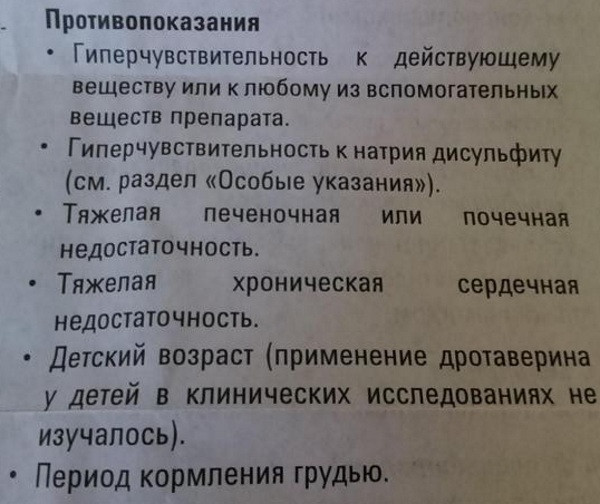
It is allowed to use No-Shpa under the supervision of a doctor:
- people suffering from low blood pressure;
- children under the age of 18.
During pregnancy
Clinical studies of drugs did not reveal any violation of embryonic development under the influence of teratogenic factors and the toxic effect of drotaverine on the fetus. Nevertheless, the appointment of No-Shpa for relieving headaches during pregnancy should be carried out with caution and strictly under the supervision of the attending physician. Prescribing a drug is allowed only if the benefits of using it significantly outweigh the possible risks to the condition of the expectant mother.
The lack of clinical trials on animals gives reason to specialists not to recommend the appointment of the drug during the lactation period.
Does it help with headaches
No-Shpa from the head is prescribed for tension pain caused by spasm of the cerebral vessels. Perceived as a tension in the head, the condition provokes the appearance of a strong pain syndrome, accompanied by dizziness, occipital pain and nausea.
Faced with this condition, patients describe the symptoms of tension headache as painful headache sensations pressing on the region of the temples, the back of the head and the bridge of the nose, which have a constant, exhausting character and intensify with excitement or stress. Unpleasant sensations with this nature of pain can last for several days. Simultaneously with them, the patient has a negative reaction to noise, harsh sounds, conversations, vivid images.
The main reason that provokes the appearance of tension headaches are various stressful situations, negative emotional states and anxiety. Also, the appearance of a spasm of the vessels of the brain can provoke constant eye strain or an uncomfortable position of the head.
The use of No-Shpa in this case will help to relax smooth muscles and relieve vascular spasm, and also activate blood circulation, which stimulates the saturation of cells with oxygen. Simultaneously with this use of the drug makes it possible to improve the general condition of the patient, to alleviate the arising on the background of painful sensations of insomnia and to prevent the further development of a negative reaction to noise and harsh sounds.
Adult use
The appointment of No-Shpa for tension headaches is permissible both as a tablet preparation and as an injection solution. The drug can be used once or used to relieve a prolonged pain syndrome caused by nervous tension or stress for 2-3 days. A single dosage of the drug for adults is 1-2 tablets, washed down with plenty of water or intramuscular injection (i / m) of 2 ml of solution.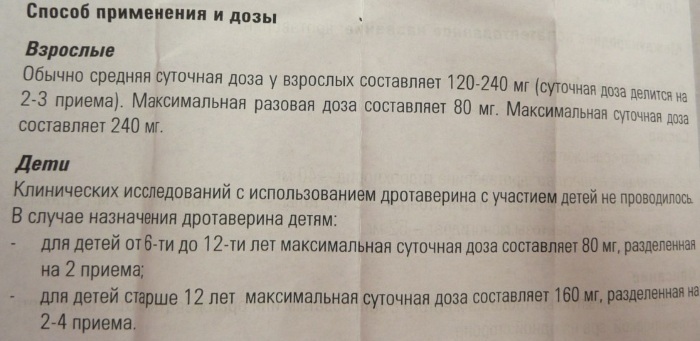
The effect of the drug reaches its maximum efficiency within 45-60 minutes from the moment of administration and lasts for up to 4-6 hours. If necessary, experts advise to repeat the drug intake.
People who have reached the age of 18 can take No-Shpu no more than 6 tablets per day (about 240 g). Experts are prohibited from self-increasing the dosage of the drug due to the risk of developing life-threatening side effects.
Application in children
Children can take the drug to relieve stress, nervous overwork headaches without consulting a doctor for no more than 1-2 days.
Prescription of the drug:
Child's age |
Drug dosage |
| 6-12 years old | 1 tablet 1-2 times a day, with a maximum daily dosage of 2 tab. (With 80 mg). |
| after 12 years | 1 tablet up to 4 times a day, 1-4 times a day, with a permissible daily dosage of 160 mg. |
The patient can evaluate the effectiveness of the drug for relieving headaches after 45-60 minutes from the moment of taking the drug. If the pain does not subside or does not decrease its intensity after taking 240 mg of the drug, experts advise the patient to seek medical help without delay.
Side effects
No-Shpa is used for spasms caused by strong eye strain or nervous strain, accompanied by narrowing cerebral vessels causing severe, prolonged temporal or occipital pain, accompanied by dizziness and nausea.
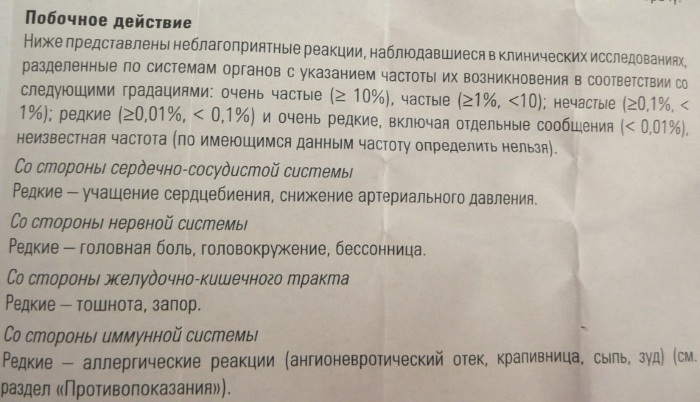
Drotaverine, which is part of the drug, according to clinical studies conducted by research workers of the Research Institute them Sklifosovsky and confirmed by specialists of the European center of the FDA, rarely provokes the appearance of side reactions.
The percentage of development of unpleasant side effects when using No-Shpa according to the gradation of the World Health Organization (WHO) is less than 0.1% and is observed to a greater extent in persons with hypersensitivity to the components of the drug funds.
According to the instructions, against the background of the use of the drug, development can be observed:
- migraine;
- sleep disturbance;
- dizziness;
- palpitations;
- lowering blood pressure indicators;
- nausea;
- constipation;
- urticaria, itching, angioedema.
Due to the fact that each No-Shpy tablet contains 52 g of lactose monohydrate, its use is undesirable in patients:
- with lactose deficiency;
- with hereditary metabolic disorders;
In case of violation, the use of the drug to relieve pain caused by spasm smooth muscle cells, can lead in such patients to the development of gastrointestinal colic and impairment chair.
Overdose
No-Shpa should be used in an amount that does not exceed the manufacturer's maximum daily dosage of 240 mg.
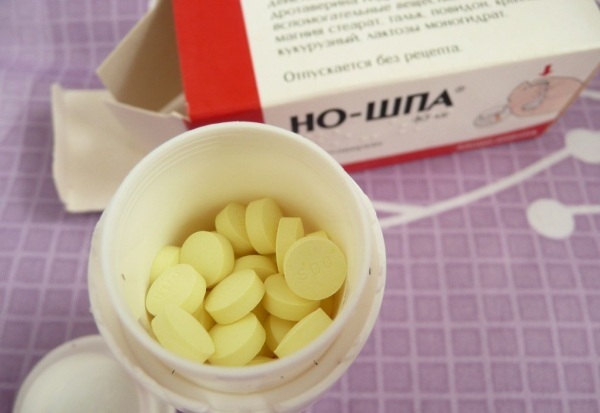
An independent increase in the amount of the drug taken leads to the development of an overdose, symptomatizing:
- heart block at the level of the His bundle and branches;
- a sharp decrease in blood pressure (BP) indicators;
- the development of nausea;
- dizziness and loss of consciousness.
In case of an overdose, the patient should immediately seek emergency medical care, and then remain under the supervision of doctors in the hospital for several days. Therapy of drug overdose includes symptomatic treatment and measures to maintain the normal functioning of the myocardium.
Also carried out:
- cleansing the stomach;
- artificial induction of vomiting.
Drug interactions
Drotaverine contained in No-Shpe, as a phosphodiesterase inhibitor, has a strong antispasmodic effect, allowing the possibility of using it for severe headaches, hepatic and renal colic, intestinal spasms musculature.
The combination of the drug with other antispasmodics and analgesics leads to an increase in the antispasmodic effect.
It is not recommended to use No-Shpa in conjunction with antiparkinsonian drugs because of the danger of a possible increase in tremor and rigidity.
No-Shpa is a drug with an antispasmodic effect, used to relax smooth muscle cells and normalize vascular circulation in the brain, narrowing and spasm of which is the main cause of headache voltage.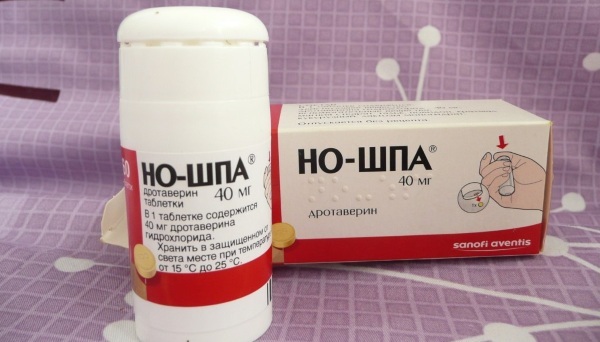
The drug, which has an inhibitory effect on phosphodiesterase, quickly eliminates severe pain syndrome, preventing further development spasm, not addictive, rarely provokes side effects and can be used from the age of 6 years, as well as in the period pregnancy.
Video about the drug No-shpa
No-shpa. What you need to know:



